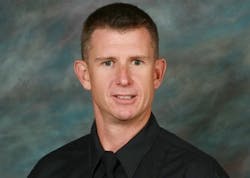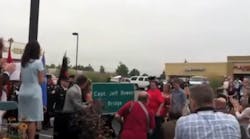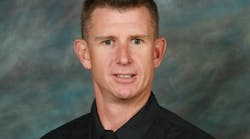NIOSH investigators have determined that a number of factors, including arson, air management issues, and lack of operational standard procedures contributed to the July 28, 2011 death of a North Carolina firefighter.
Asheville Fire Capt. Jeffrey Bowen, 37, a 13-year-veteran, was battling an arson fire in a high-rise when things went terribly wrong.
“The low-air alarms of the victim and two fire fighters were sounding when they reached the hallway that was connected to the fire rooms. One of the fire fighters grabbed the victim, who was acting confused, and started back to the stairwell…” according to the report.
One firefighter who was with Bowen told investigators he thought about calling a Mayday because he was critically low on air, but didn’t.
NIOSH said in the report released late Monday that “If fire fighters (sic) find themselves in a questionable position (dangerous or not), they must be able to recognize this and be trained on procedures for when and how a Mayday should be called. A fire fighter's (sic) knowledge, skill, and ability to declare a Mayday must be at the mastery level of performance…”
The probe also showed that the victim and fellow firefighters had issues while trying to share air.
“…The victim ran out of air and told his partner they needed to buddy breath. The victim unclipped his regulator as his partner connected the buddy breather and all the partner's air escaped through the victim's SCBA. The victim transmitted a Mayday and activated his PASS (personal alarm safety system). The fire fighter also attempted to activate his PASS, called several Maydays prior to removing his mask and began looking for an escape path…”
Federal investigators said Bowen activating his PASS likely saved the other firefighter because his got shut off.
Based on that, NIOSH suggests all departments “Ensure that fire fighters are properly trained in out-of-air SCBA emergencies and SCBA repetitive skills training (e.g., buddy breathing and clearing a facepiece).”
Other suggestions include:
- Ensure that the existing standard operating procedures for high-rise fire-fighting operations are reviewed, implemented, and enforced.
- Ensure that a deployment strategy for low-frequency/high-risk incidents is developed and implemented.
- Ensure that the incident commander develops an incident action plan, which is communicated to all fire fighters on scene, and includes effective strategy and tactics for high-rise operations, a timely coordinated fire attack, and a coordinated search plan.
- Ensure that the incident commander utilizes division/group supervisors for effective tactical-level management.
- Ensure that fire fighters are properly trained in air management.








